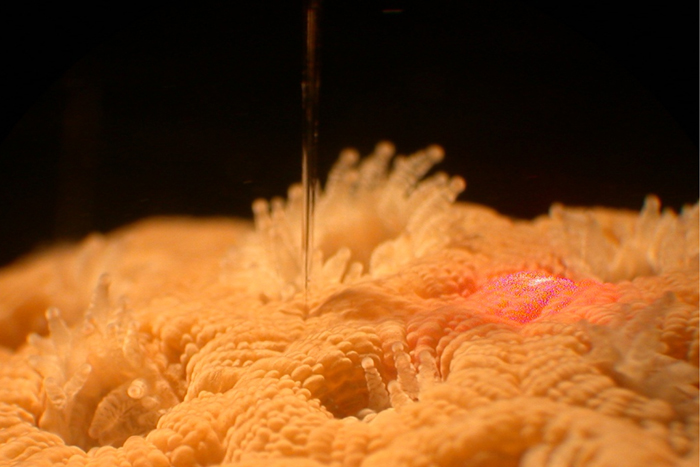Corals Trap Light to Help Algae Friends

Corals live in symbiosis with their algal tenants — algae provide corals with carbohydrates, oxygen and energy, while corals shelter algae and feed them nutritious waste products, such as carbon dioxide. Driving this mutually beneficial relationship is sunlight, which the algae use to produce oxygen and other nutrients in a process called photosynthesis.
New research published today (Feb. 12) in the Journal of Experimental Biology shows that corals play a vital role in making sure their algae friends get the sunlight they require.
Using light sensors, scientists have determined that coral tissue traps and redistributes light over the coral colony. This transmitted light increases the algae's photosynthesis, resulting in more oxygen for the coral. What's more, the wavelengths of light that the tissues scatter the most are those that the algae use best.
"Most of the scattering is in the shorter wavelengths, and this overlaps with the algae's photopigment absorption," said study author Daniel Wangpraseurt, an aquatic ecology Ph.D. student at Australia's University of Technology, Sydney. "The relationship is quite smart."
Scattering light
Previous studies investigating how corals redistribute light have focused on dead coral skeletons, Wangpraseurt told Live Science. In 2005, researchers found that coral skeletons highly reflect light in all directions. More recently, scientists learned that the light reflectance of coral skeletons is highly variable — some species are much poorer at scattering light than others.
Until now, researchers thought that coral tissue didn't redistribute light like coral skeletons do. They assumed that the tissue's refractive index — a measurement of how much light slows down and bends when traveling between mediums — was the same as water. This would mean, essentially, that the light's trajectory wouldn't change much, if at all, as it traveled from seawater through coral tissue.
Get the world’s most fascinating discoveries delivered straight to your inbox.
But in 2012, Wangpraseurt and his colleagues discovered that the amount of light present in the lower and upper layers of coral tissue isn't the same. Looking into the scientific literature, they also found that certain layers of tissues are high in protein, which could potentially affect the refractive index and result in light scattering.
To find out if coral tissue really can trap and retransmit light, the researchers collected healthy brain corals from the Heron Island Research Station on the Great Barrier Reef. While shining near-infrared laser light or red laser light onto the coral samples, they inserted light microsensors into the coral tissues to see how far the light propagated vertically and horizontally. [Images: Colorful Corals of the Great Barrier Reef]
They detected both the red and near-infrared light as far away as 0.8 inches (20 millimeters) from the tissue area directly illuminated by the laser beams. Closer examination of the light distribution suggested that the near-infrared light, which the algae don't use for photosynthesis, actually passed right through the coral tissue — the coral skeleton reflected the light back to the animal's tissue. On the other hand, the tissue did trap and laterally transport the red light, which the algae's photopigments absorb for photosynthesis.
Improving photosynthesis
To see if the algae actually made use of the scattered light, the team repeated the experiment with a different microprobe. "We exchanged the light sensor for an oxygen sensor," Wangpraseurt said. Flicking the red light on and off resulted in rapid increases and decreases in oxygen concentrations in areas up to about a centimeter (0.4 inches) from the laser beam. That is, the scattered light improved the algae's overall photosynthesis.
The researchers also used a fluorescent imaging technique to see if the algae could use the redistributed light (during photosynthesis, the light-absorbing chlorophyll molecules in plants fluoresce, or re-emit some light). The team shone red, green and violet light onto the coral tissues, and found that each of the colors caused the algae to fluoresce strongly up to 6 mm (0.24 inches) from the laser beam.
Interestingly, corals can control the amount of light that gets scattered, the researchers found. In low light conditions, coral tissues expand, allowing more light to scatter; when faced with a lot of light, they contract and reduce the light propagation.
"They are able to reorganize the light exposure to their algae more than we previously thought," Wangpraseurt said. This ability may help the corals protect themselves and their symbionts from light-induced stress, which is known to cause coral bleaching.
Follow Joseph Castro on Twitter. Follow us @livescience, Facebook & Google+. Original article on Live Science.



